Traders stampeded out of gold, emerging markets and bonds this month, setting record monthly outflows in June. Ever since the Federal Reserve hinted in May that signs of a stronger economy could allow for a slowdown of stimulus, markets have protested the news.
Gold has been hit hard by the tapering talk and resultant rising interest rates and liquidity drain, falling below $1,200 last week for the first time since August 2010. We’re also seeing India, the world’s biggest gold buyer, trying to stifle gold demand. As the government seeks to reduce its record current account deficit, it has hiked import tariffs on gold to 8 percent and introduced new constraints on rural lending against gold jewelry and coins. Ross Norman, CEO of bullion broker Sharps Pixley, said, “It’s almost as if the finance ministry is waging war on the gold sector, which would suggest that they feel they have lost control of the economy to some extent. In that environment, you would want to own gold more than ever.”
Other factors fueling the liquidation were the raising of margin requirements on gold by the CME Group, the largest operator of futures exchanges in the U.S., and global liquidity concerns in the U.S. and China. When the country with the largest GDP in the world and the country with the largest population on earth have liquidity concerns, traders run from stocks, bonds and gold and head to cash. Even though gold traders have pulled out of their financial investments, there has been a surge in physical gold buying and central bankers have maintained their positions.
We maintain that gold is in extremely oversold territory and mathematically due for a reversal toward the mean. Yet when gold prices plummet, fear takes over and some investors forget the fundamental reasons to own gold: Gold is a portfolio diversifier and a store of value. It is a finite resource with increasing global demand. I co-authored a book on gold five years ago based on a lifetime of experience with the metal. My advice hasn’t changed since then. When it comes to gold, moderation is key. Don’t try to get rich with gold because the corresponding risk is simply too high. Limit your exposure to gold as an asset class to 10 percent of your portfolio – no more than 5 percent in bullion and 5 percent in equities. Rebalance each year to keep that level of exposure and use volatility to your advantage.
There seems to be an inherent emotional bias against gold by many in the financial media and among money managers, especially after gold corrects. Billions of dollars lost in gold make for sensational headlines, yet two darling technology stocks have also taken it on the chin. I find it interesting that the naysayers aren’t talking about the fact that Facebook and Apple have caused more destruction in market capitalization over the past year than the biggest gold ETF. The chart below puts the magnitude of decline in context.
Why is it that gold still struggles for acceptance as a permanent asset class? I, too, enjoy catching up with Facebook friends on my iPad, but I have more faith that millions of people in Asia and the Middle East will continue to adore the precious metal long after the novelty of Facebook and iPads wears off.





